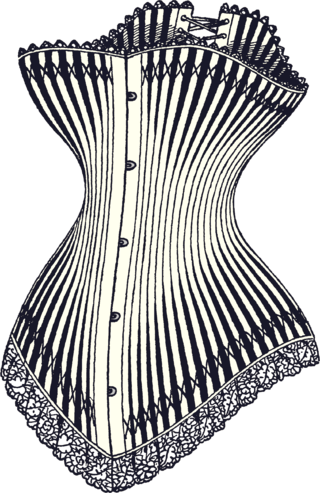
A corset is a support garment commonly worn to hold and train the torso into a desired shape, traditionally a smaller waist or larger bottom, for aesthetic or medical purposes, or support the breasts. Both men and women are known to wear corsets, though this item was for many years an integral part of women's wardrobes.
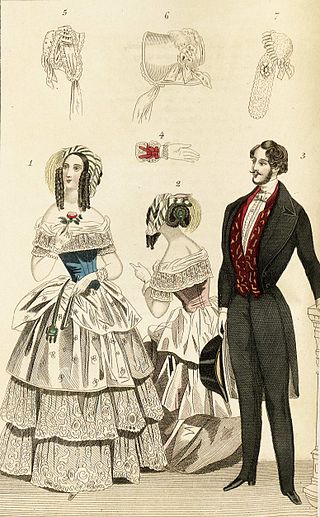
Victorian fashion consists of the various fashions and trends in British culture that emerged and developed in the United Kingdom and the British Empire throughout the Victorian era, roughly from the 1830s through the 1890s. The period saw many changes in fashion, including changes in styles, fashion technology and the methods of distribution. Various movement in architecture, literature, and the decorative and visual arts as well as a changing perception of gender roles also influenced fashion.
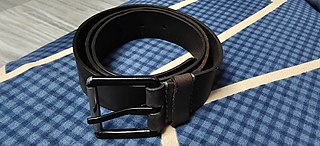
A belt is a flexible band or strap, typically made of leather, plastic, or heavy cloth, worn around the natural waist or near it. The ends of a belt are free; and a buckle forms the belt into a loop by securing one end to another part of the belt, at or near the other end. Often, the resulting loop is smaller than the hips. Belts come in many lengths because of the variety in waist sizes, and most belts can be adjusted at the buckle to suit the wearer's waist.

Tightlacing is the practice of wearing a tightly laced corset. It is done to achieve cosmetic modifications to the figure and posture or to experience the sensation of bodily restriction.

The waist is the part of the abdomen between the rib cage and hips. On people with slim bodies, the waist is the narrowest part of the torso.

A corsetmaker is a specialist tailor who makes corsets. Corsetmakers are frequently known by the French equivalent terms corsetier (male) and corsetière (female). Staymaker is an obsolete name for a corsetmaker.
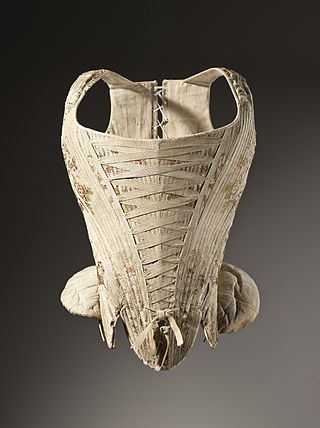
The corset is a supportive undergarment for women, dating, in Europe, back several centuries, evolving as fashion trends have changed and being known, depending on era and geography, as a pair of bodies, stays and corsets. The appearance of the garment represented a change from people wearing clothes to fit their bodies to changing the shape of their bodies to support and fit their fashionable clothing.

Fashion in the 1890s in European and European-influenced countries is characterized by long elegant lines, tall collars, and the rise of sportswear. It was an era of great dress reforms led by the invention of the drop-frame safety bicycle, which allowed women the opportunity to ride bicycles more comfortably, and therefore, created the need for appropriate clothing.
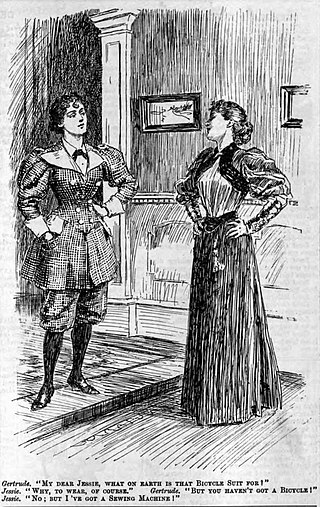
Victorian dress reform was an objective of the Victorian dress reform movement of the middle and late Victorian era, led by various reformers who proposed, designed, and wore clothing considered more practical and comfortable than the fashions of the time.
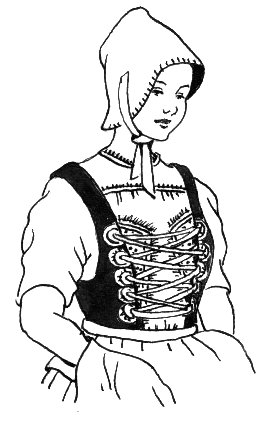
A bodice is an article of clothing traditionally for women and girls, covering the torso from the neck to the waist. The term typically refers to a specific type of upper garment common in Europe during the 16th to the 18th century, or to the upper portion of a modern dress to distinguish it from the skirt and sleeves. The name bodice is etymologically an odd plural spelling of "body" and comes from an older garment called a pair of bodies.

A ball gown, ballgown or gown is a type of evening gown worn to a ball or a formal event. Most versions are cut off the shoulder with a low décolletage, exposed arms, and long bouffant styled skirts. Such gowns are typically worn with an opera-length white gloves, vintage jewelry or couture, and a stole, cape, or cloak in lieu of a coat. Where "state decorations" are to be worn, they are on a bow pinned to the chest, and married women wear a tiara if they have one. Although synthetic fabrics are now sometimes used, the most common fabrics are satin, silk, taffeta and velvet with trimmings of lace, pearls, sequins, embroidery, ruffles, ribbons, rosettes and ruching.

Empire silhouette, Empire line, Empire waist or just Empire is a style in clothing in which the dress has a fitted bodice ending just below the bust, giving a high-waisted appearance, and a gathered skirt which is long and loosely fitting but skims the body rather than being supported by voluminous petticoats. The outline is especially flattering to pear shapes wishing to disguise the stomach area or emphasize the bust. The shape of the dress also helps to lengthen the body's appearance.

A foundation garment is an undergarment designed to impermanently alter the wearer's body shape, to achieve what some view as a more fashionable figure. The function of a foundation garment is not to enhance a bodily feature but to make it look more presentable.

An hourglass corset is a garment that produces a silhouette resembling an hourglass shape characterized by wide hips, narrow waist, and wide bust.

Fashion in the period 1795–1820 in European and European-influenced countries saw the final triumph of undress or informal styles over the brocades, lace, periwigs and powder of the earlier 18th century. In the aftermath of the French Revolution, no one wanted to appear to be a member of the French aristocracy, and people began using clothing more as a form of individual expression of the true self than as a pure indication of social status. As a result, the shifts that occurred in fashion at the turn of the 19th century granted the opportunity to present new public identities that also provided insights into their private selves. Katherine Aaslestad indicates how "fashion, embodying new social values, emerged as a key site of confrontation between tradition and change."

The hourglass figure is one of four traditional female body shapes described by the fashion industry. The other shapes are the rectangular, inverted triangle, and spoon/pear. The hourglass shape is defined by a woman's body measurements- the circumference of the bust, waist and hips. Hourglass body shapes have a wide bust, a narrow waist, and wide hips with a similar measurement to that of the bust. This body shape is named for its resemblance to that of an hourglass where the upper and lower half are wide and roughly equal while the middle is narrow in circumference, making the overall shape wide-narrow-wide. Women who exhibit the hourglass figure have been shown to be more admired, which can put pressure on women whose body shapes are noticeably different to strive to achieve the hourglass figure. This can lead to body dissatisfaction which can cause eating disorders in young women from all over the globe.
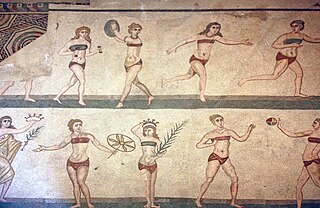
The history of bras is closely tied to the social status of women, the evolution of fashion, and shifting views of the female body over time.

Metal corsets are a type of historical corset or bodice made entirely out of metal, usually iron or steel. The metal corset was popularly claimed to have been introduced to France by Catherine de' Medici in the 16th century, although this is now considered a myth. The idea that such garments were worn for fashionable purposes is debatable, with fashion historians now regarding such claims sceptically. Many of the original metal bodices that have survived are now believed to have been intended for medical purposes as orthopaedic support garments and back braces. Such garments were described by the French army surgeon Ambroise Paré in the 16th century as a remedy for the "crookednesse of the Bodie."

The corset controversy concerns supporters' and detractors' arguments for and against wearing a corset. The controversy was contemporary with the time that corsets were popular in society. Corsets, variously called a pair of bodys or stays, were worn by European women from the late 16th century onward, changing their form as fashions changed. In spite of radical change to fashion geographically and temporally, the corset or some derivative beneath an outer gown shaped the body or provided structure.
Hourglass Angel is an American apparel company producing and selling waist trainers, shapewear, corsets, and other undergarments by several brands, including its own private label. It was founded by Ruben Soto in 2008 and is headquartered in Illinois. In 2016 Hourglass Angel was one of the 5,000 fastest growing companies in America, and Soto was included in Forbes 30 Under 30.





















